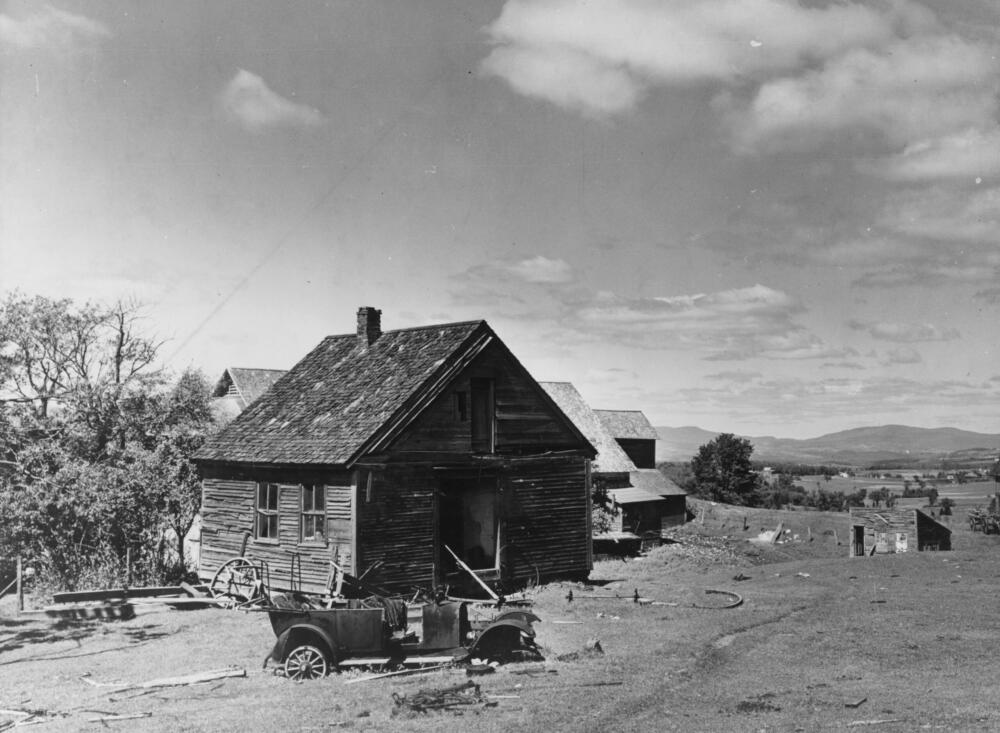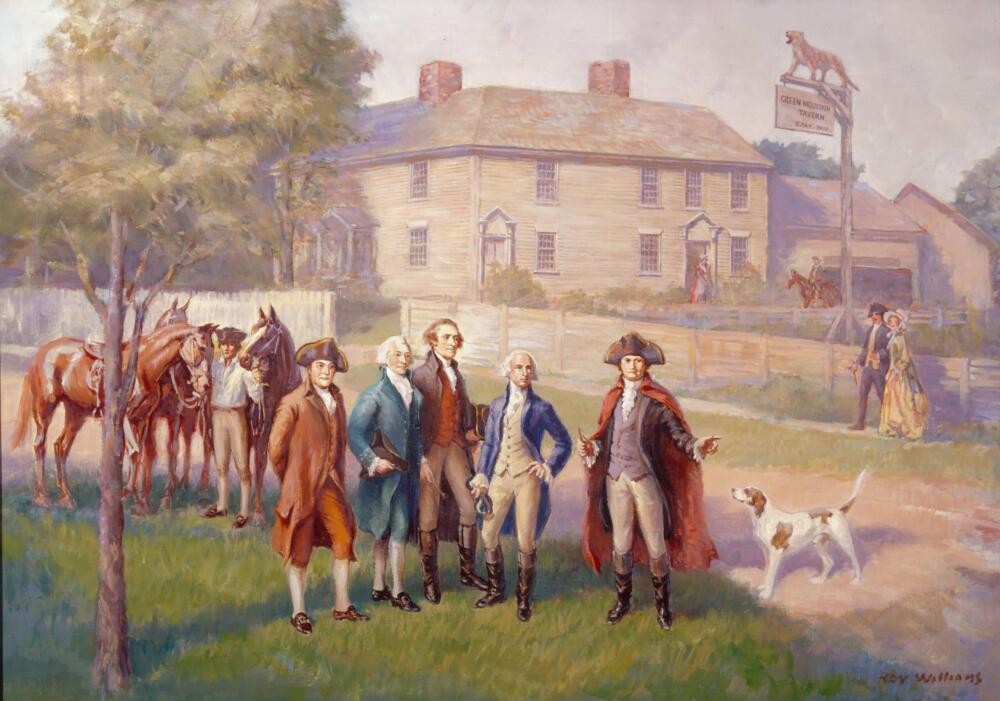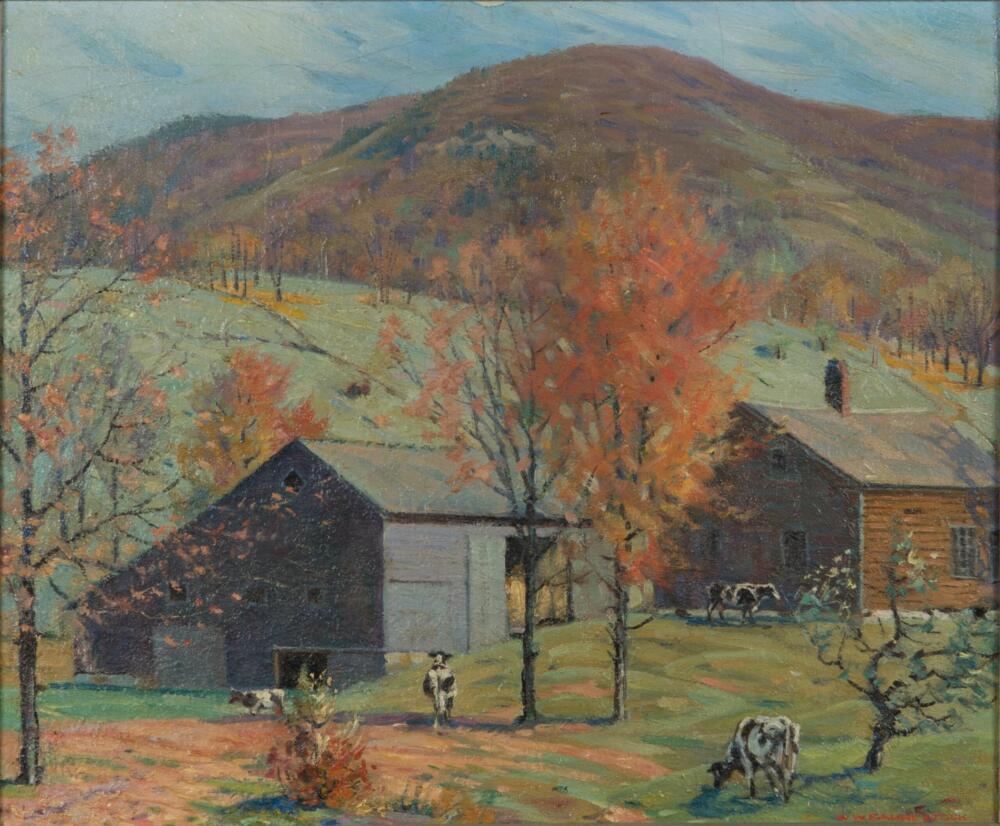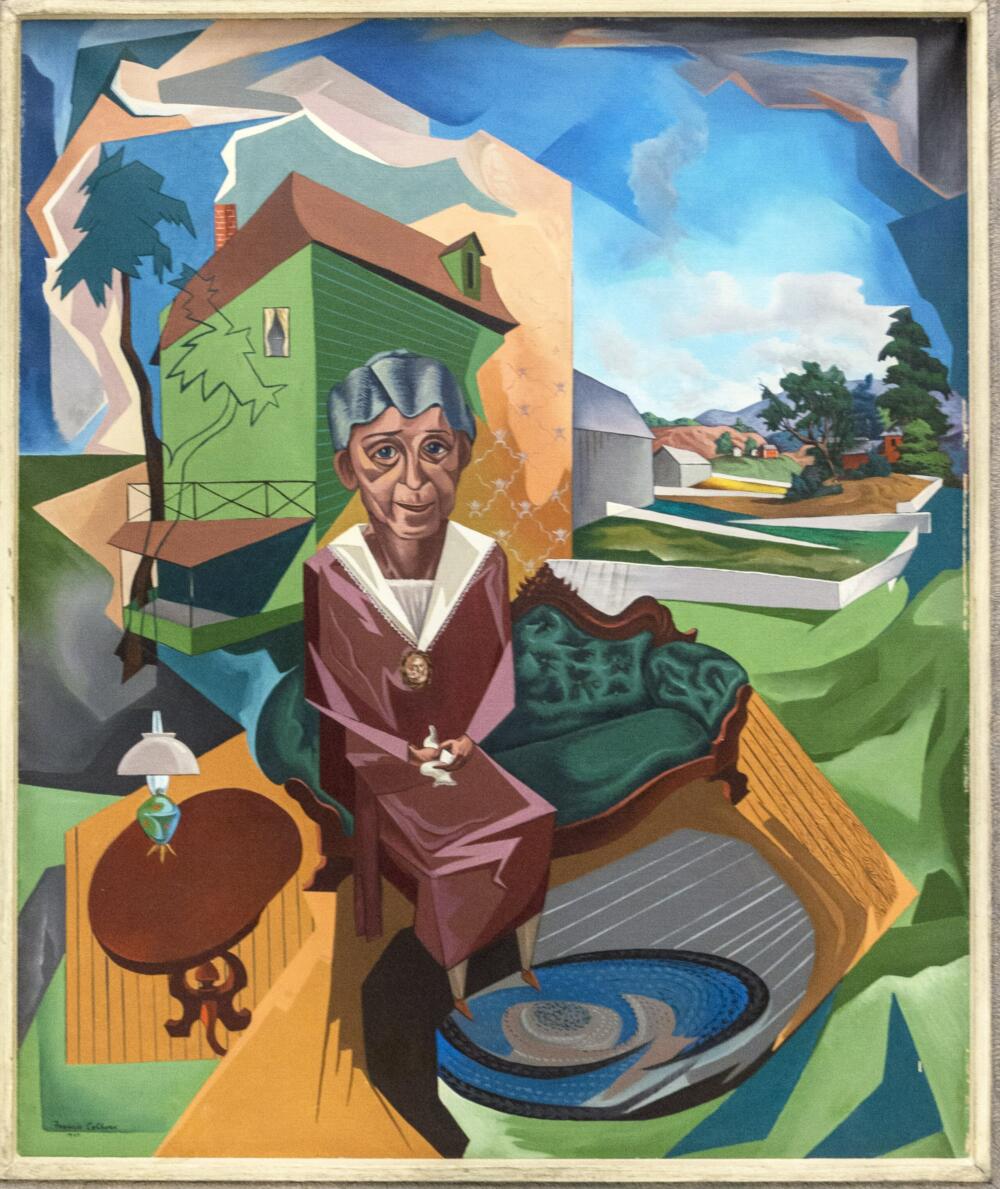For Immediate Release: July 11, 2018
Contact: Susan Strano, Marketing Director
sstrano@benningtonmuseum.org
802-447-1571 ext. 204

Old Abandoned Farmhouse near Newport, Vermont, August 1936, Carl Mydans
Images:
Old Abandoned Farmhouse near Newport, Vermont, August 1936
Carl Mydans (1907-2004)
Modern digital print from scan of original nitrate negative, 8 x 10 inches
Courtesy of the Library of Congress
Charley Smith and His Barn, c. 1939
Francis Colburn (1909-1984)
Oil on canvas, 34 x 39 inches
Collection of Bennington Museum
More images associated with each category are listed below.
Crash to Creativity: THE NEW DEAL IN VERMONT
The days were dark as the Stock Market Crash of 1929 took its toll on the country in the early 1930s. It has often been said that the Depression didn’t have much impact in Vermont. “Depression, what Depression?” was the quip. Vermont had always been a hard-scrabble place and the Depression just forced farmers and shop-keepers into a local barter-based economy. But the state of Vermont was not spared. Many of those in the towns, as well as those living by the land, saw their lives crumble before them.
However, 1934-1944 was also a time of immense creativity and innovation in the Green Mountain State. Artists, architects, writers, construction workers, and civil employees, whose work was funded through Federal New Deal programs, helped to document the state’s history, record the conditions of contemporary life during the Depression and recovery, and build infrastructure that continues to benefit us today.
On view at the Bennington Museum through November 4, Crash to Creativity: The New Deal in Vermont sheds light on the important, under-studied aspect of Vermont’s history, focusing on the role of these many government sponsored New Deal projects. “True to Bennington Museum’s strength, combining art and history in innovative ways, the exhibition features photography, paintings, prints of post office murals, and architectural drafts that were sponsored through the government’s New Deal programs. Powerful examples of Regionalist and Social Realist paintings include Francis Colburn’s Charley Smith and His Barn, and Ronald Slayton’s quietly optimistic The Planter.” states Robert Wolterstorff, Executive Director of Bennington Museum. Also on view is furniture from Civilian Conservation Corps (CCC) cabins, archival documentation of New Deal projects such as letters, as well as transcriptions of audio recordings of Vermonters created by the Federal Writers Project.
The exhibition examines three thematic topics: Preserving the Past, Inventing the Present, and Building the Future.

Meeting at Fay’s Tavern (Thomas Jefferson and James Madison, Bennington, June 1791), 1938, Leroy Williams
Preserving the Past
Meeting at Fay’s Tavern (Thomas Jefferson and James Madison, Bennington, June 1791), 1938
Leroy Williams (1878-1965)
Oil on canvas, 25 x 35.25 inches
Collection of Bennington Museum
Portrait of Rev. Lemuel Haynes, 1940
Eugene H. Bischoff (1880-1954)
Oil on canvas, 30 x 40 inches
Collection of Bennington Museum
Vermont’s culture has long been shaped by an interdependent relationship between traditional values and progressive ideals. Having survived moderate economic hardship since the mid-nineteenth century, the Green Mountain state could not afford further losses. Despite a tradition of local pride and stubborn independence, the effects of the Depression opened Vermont to many aspects of Roosevelt’s liberal New Deal.
Many of the projects created through the New Deal helped to solidify stories that had been told and retold, passed down by one generation of Vermonters to the next, such as the Battle of Bennington and the Green Mountains Boys. Bennington Museum collaborated with a handful of artists, through the state’s Federal Art Project, to create large scale murals and easel paintings documenting local historical events and people of particular note. The resulting works included a six by twelve foot mural by Leroy Williams depicting the aftermath of the Battle of Bennington on view in the Museum’s military gallery, and an easel painting depicting a visit to Bennington from Thomas Jefferson and James Madison in 1791 – Meeting at Fay’s Tavern, 1791. These historical images, while carefully researched, tended to create a cohesive, white-washed picture of Vermont’s past.
“However, a few of these projects told lesser known aspects of the state’s history, challenged the wisdom that was passed down through the generations, and added a layer of complexity to Vermont’s cultural landscape such as the mural and easel painting of Rev. Lemuel Haynes commissioned by the Bennington Museum.” states Jamie Franklin, curator of Bennington Museum. Rev. Lemuel Haynes, was the first black man to be ordained as a minister in America and had a long career preaching to largely white congregations in his home towns of West Rutland, Vermont, and adjacent Granville, New York, and the surrounding region from 1788 to 1831. It is the preservation of both histories – the widely viewed and the less known – that created the true history of Vermont.

Vermont Idyll, 1938, Wallace Weir Fahnestock
Inventing the Present
Vermont Idyll, 1938
Wallace Weir Fahnestock (1877-1962)
Oil on canvas, 20 ¼ x 24 ¼ inches
Collection of Bennington Museum
Hired Man, c. 1937
Ronald Slayton (1910-1992)
Oil on homasote, 33 x 47 1/2 inches
Collection of Robert Hull Fleming Museum
Vermont Idyll, 1939 by Wallace Weir Fahnestock (1877-1962) is emblematic of the type of Regionalist, American Scene paintings that were created in Vermont as part of the Federal Art Project, perhaps the longest running and most successful of the many visual arts programs sponsored by the Federal government under the Works Progress Administration and the New Deal at large.
“As a whole, from easel paintings and prints to photographs and post office murals, the creative output of the New Deal in Vermont helped to crystalize the traditional marketing and tourist image of Vermont as a picturesque, “old time” New England.” states Franklin. A survey of the themes most often explored, range from agricultural production-including haying and dairy farming- and maple sugaring, to marble and granite quarrying, and the budding recreation industry, notably skiing. This idealized image of Vermont, was and continues to be used by the state’s tourist marketing programs to the present day
However, artists like Francis Colburn and Ronald Slayton, two of the most significant native Vermont artists to participate in the Works Progress Administration’s Federal Art Project (FAP) produced bodies of work that are notable for their powerful sense of place and willingness to address important, sometimes difficult social issues. Much of their work was in line with the Regionalist subject matter popular with many artists working through the FAP, depicting typical Vermont people and landscapes. On the other hand, some of their work, especially Slayton in his painting Unemployed and suite of three woodcuts, Clearing the Fields, Fuel, and Social Activities of the ‘30s, directly tackled many of the dire economic, political, and social problems facing Vermonters during the Depression. “Both artists depicted hard working Vermonters, farmers, quarry men, factory workers and their families, with dignity and respect. In paintings such as Colburn’s Charley Smith and his Barn, Granite Quarry, and Family Group, and Slayton’s Mowing Away, Hired Man, and Burlington Gothic, both artists make their humanist desire for better working and living conditions for their fellow Vermonters an overriding theme of their work.” remarks Franklin.
The Federal Writer’s Project (FWP) was one of the five major work relief programs sponsored by the WPA. This program is best remembered for the American Guide Series. Every major city and town in all 48 states in the union, plus Alaska and Puerto Rico, was documented. This program employed over 6,000 writers. The format included essays on the state’s history and culture, descriptions of its major cities, automobile tours of important attractions, and photographs. “In addition to the guidebooks, the authors working for the Federal Writers’ Project conducted extensive interviews with locals that were seen to be typical of a particular city or region, which were used to draft narrative accounts that provide insightful, deeply personal insights into life in a particular part of the country during the Great Depression. These narratives were largely unpublished during the active run of the FWP, but the manuscripts are now part of the collection of the Library of Congress. Excerpts from these manuscripts telling about various aspects of life in Vermont are included in a handful of labels throughout this exhibition.” states Franklin.

Social Security, 1947, Francis Colburn
Building the Future
Social Security, 1947
Francis Colburn (1909-1984)
Oil on canvas, 42 x 36 inches
Collection of Vermont Historical Society, Gift of Ruth P. Bogorad, Shelburne, VT
Ski Lodge, Mt. Mansfield, Stowe, Vermont, c. 1938
David Fried (1911-1990)
Graphite on paper
Collection of Mark Fried
As a part of the Emergency Work Act implemented in 1933, the Civilian Conservation Corps, or CCC was created. Under this Act, thousands of young men were recruited to work planting forests and creating parks, building roads and dams, and pursuing other conservation activities.
Vermont had one of the earliest and most productive CCC projects in the country. Unlike many other states, Vermont was prepared with public lands and development projects for the 40,800 men who were eventually assigned to CCC camps here. Since 1909 the state had acquired thousands of acres of land for forests and parks but had been able to develop only two picnic areas by 1933.
Most of the buildings that were built for the state park system with CCC labor were rustic structures utilizing readily accessible local materials, including rough-hewn logs and stone. “David Fried, who received his training at Cornell University’s School of Architecture and graduated in 1933, spent his first few years out of school designing rustic buildings in Vermont and New Hampshire for the National Park Service. He was one of the few known architects of these buildings that injected a modernist sensibility to his work. His known designs for the CCC in Vermont include the bathhouse at Crystal Lake State Park, the base lodge at Mount Mansfield in Stowe, and the lookout tower at Mount Philo, Charlotte. The lodge at Mount Mansfield is one of his distinctive buildings that blend rustic and modern design.” states Franklin.
The CCC also had a significant role in the birth and early development of Vermont’s ski industry. Perry Merrill, State CCC Director and Commissioner of the Vermont Forestry Service, saw the potential for winter recreation in the state forests if a network of ski trails could be built. One of the most impressive undertakings was the work done on Mt. Mansfield (now known as Stowe Mountain Resort). Here ski trails, ski lifts, a base house, and other elements of the infrastructure were built. On view in Crash to Creativity: The New Deal in Vermont are some of the architectural renderings and early photos documenting this project. The CCC also had a hand in the ski facilities now operating on Bromley, Okemo, and Burke Mountains, as well as defunct areas in St. Albans and Shrewsbury. It was through these efforts that a large part of the state’s infrastructure was built and continues to benefit us today.
Poverty among the elderly grew dramatically during the Depression. It is estimated that in 1934 over half of the elderly in America lacked sufficient income to be self-supporting. On August 14, 1935, the Social Security Act established a system of old-age benefits for workers, benefits for victims of industrial accidents, unemployment insurance, aid for dependent mothers and children, the blind, and the physically handicapped.
Social Security by Francis Colburn depicts an old woman, surrounded by outdated Victorian furniture. She is the embodiment of a Vermont Social Security recipient. “This painting represents one of the New Deal’s most powerful legacies.” remarks Jamie Franklin. Ida May Fuller of Ludlow, Vermont, was the first beneficiary of recurring monthly Social Security payments. She filed her retirement claim on November 4, 1939, having worked under Social Security for a little short of three years. She received the first Social Security check, check number 00-000-001, in the amount of $22.54 and dated January 31, 1940.
Supported by programs funded through the New Deal, the creative and innovative work of artists, architects, writers, construction workers, and civil employees, continues to benefit us today.
About the Museum
Bennington Museum is located at 75 Main Street (Route 9), Bennington, in The Shires of Vermont. The museum is open 10 am to 5 pm daily through October. It is wheelchair accessible. Regular admission is $10 for adults, $9 for seniors and students over 18. Admission is never charged for younger students, museum members, or to visit the museum shop. Visit the museum’s website www.benningtonmuseum.org or call 802-447-1571 for more information.
Bennington Museum is a member of ArtCountry, a consortium of notable art and performance destinations in the scenic northern Berkshires of Massachusetts and southern Green Mountains of Vermont, including The Clark Art Institute, Williams College Museum of Art , Williamstown Theatre Festival (20 minutes away); and MASS MoCA (25minutes away). Visit ArtCountry.org for more information on these five great cultural centers.
